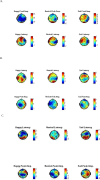Effect of Bumetanide on Neural Correlates of Emotion Recognition in Youth With Autism Spectrum Disorder: An Event-related Potential Study
- PMID: 40655087
- PMCID: PMC12248174
- DOI: 10.32598/bcn.2023.3978.1
Effect of Bumetanide on Neural Correlates of Emotion Recognition in Youth With Autism Spectrum Disorder: An Event-related Potential Study
Abstract
Introduction: Individuals with autism spectrum disorder (ASD) have impairments in emotion processing, including recognizing facial emotions. There is a significant need for medication to improve core symptoms of ASD. Bumetanide is one of the most recently used drugs in some studies of ASD to address this need. This study aimed to evaluate the effect of bumetanide on the brain response of youth with ASD while they were recognizing facial emotions using the event-related potentials (ERPs).
Methods: Fifteen children with ASD aged between 7 to 16 years were evaluated using the childhood autism rating scale (CARS), schedule for affective disorders and schizophrenia for school-age children-present and lifetime version, social responsiveness scale, Wechsler intelligence scale for children-revised form, and standard blood tests. The electrical brain response was measured while they were doing a facial emotion recognition task (FERT). After 3 months of treatment, they were assessed again regarding core symptoms and ERPs.
Results: The behavioral problems of the participants decreased significantly based on CARS. With regard to behavioral performance on FERT, the accuracy of detecting emotions increased, and reaction time decreased significantly. The amplitude of N170, EPN, and N250 increased, and latency for N170 and N250 decreased significantly in some electrodes. There were no serious side effects.
Conclusion: In this study, bumetanide improved behavioral symptoms and recognition of facial emotions. Also, brain function was improved based on the ERP components. So, bumetanide can be used safely in children and adolescents with ASD to improve the main symptoms of the disorder.
Keywords: Autism spectrum disorder (ASD); Bumetanide; Event-related potentials (ERPs); Facial emotion recognition.
Copyright© 2025 Iranian Neuroscience Society.
Figures


Similar articles
-
Memantine for autism spectrum disorder.Cochrane Database Syst Rev. 2022 Aug 25;8(8):CD013845. doi: 10.1002/14651858.CD013845.pub2. Cochrane Database Syst Rev. 2022. PMID: 36006807 Free PMC article.
-
Methylphenidate for children and adolescents with autism spectrum disorder.Cochrane Database Syst Rev. 2017 Nov 21;11(11):CD011144. doi: 10.1002/14651858.CD011144.pub2. Cochrane Database Syst Rev. 2017. PMID: 29159857 Free PMC article.
-
Pharmacological intervention for irritability, aggression, and self-injury in autism spectrum disorder (ASD).Cochrane Database Syst Rev. 2023 Oct 9;10(10):CD011769. doi: 10.1002/14651858.CD011769.pub2. Cochrane Database Syst Rev. 2023. PMID: 37811711 Free PMC article.
-
The Black Book of Psychotropic Dosing and Monitoring.Psychopharmacol Bull. 2024 Jul 8;54(3):8-59. Psychopharmacol Bull. 2024. PMID: 38993656 Free PMC article. Review.
-
Signs and symptoms to determine if a patient presenting in primary care or hospital outpatient settings has COVID-19.Cochrane Database Syst Rev. 2022 May 20;5(5):CD013665. doi: 10.1002/14651858.CD013665.pub3. Cochrane Database Syst Rev. 2022. PMID: 35593186 Free PMC article.
References
-
- American Psychiatric Association (APA) . (2013). Diagnostic and statistical manual of mental disorders: DSM-5TM, 5th ed. Arlington: American Psychiatric Publishing. [DOI: 10.1176/appi.books.9780890425596] - DOI
LinkOut - more resources
Full Text Sources
